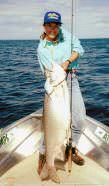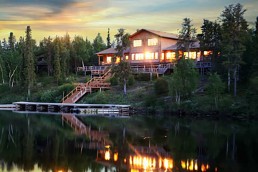The Monsters of Athabasca
During the past 25 years or more, Dan Gapen Sr. has been my constant fishing companion, one who’s been willing to share all the knowledge he possesses. It’s hard to count the number of times we’ve headed north into Canada to engage that country’s bountiful supply of gamefish. Take those trips to Lake Athabasca—Dan’s favorite body of water for trophy lake trout and northern pike. Dan liked the latter two weeks of July to head for Athabasca, mainly because the trophy lake trout were still up in the shallows and the cabbage weed was tall, where the pike are known to hold in.
We arrived at Cliff and Stella Blackmurs’, owners of Athabasca Fishing Camps, on July 20 ready to take on the monsters of the MacFarlane River. This time we carried some specially designed ash wood crankbaits. At the time, these crankbaits were the largest short-nosed cranks on the market. Dan designed them by hand during the winter prior to our trip. The “Ol’ Man,” as I affectionately call Dan, called them “Crankmasters.” The idea for their design had come the previous year, when a 27-pound lake trout coughed up a 3-pound whitefish as it was being netted. I can still hear Dan’s comment:
“Anne, now that’s a lure! I’ve always said big bait, big fish,” he remarked, as he released the trout.
We’d keep the whitefish to be smoked in the resort’s smoke house; it was still alive and in excellent condition.
There were other reasons to fish oversized lures. The year before, Dan filmed the attack of a 50-pound-plus laker, as it attacked and attempted to eat an 8-pound laker I was fighting. The huge fish was determined to engage the smaller fish, T-boning it several times during the underwater battle. Three times the monster disengaged the 8-pounder and attacked the camera lens, possibly thinking it was housing a competitor that was after his dinner. One of these attacks saw the 50-pounder completely cover the lens with its mouth as the camera rolled—fantastic footage, needless to say.
It was an hour boat ride from the resort out to the main lake where the MacFarlane River entered in the northeast corner. The ride was exhilarating with colder summer air, created by the cold water of Athabasca. A soft breeze from the southwest was met as we rounded Poplar Point, a favorite trophy lake trout spot. We’d not stop here, but ran south to where the water plunged deep a half-mile off the river’s mouth. Upon arriving at the spot we’d found the previous year, four seagulls were seen darting above the water’s surface in a cut where wave action had carved out a deep channel in the sandy bottom. Fish must be feeding below surface in the cut. Immediately, our guide set course to troll the new Crankmaster up the center of the cut. Dan’s new lure would dig deep to 25 feet. The cut was surrounded by 20-foot-deep sandbanks and was 42 feet in depth.
“If there are big trout in that cut feeding on a school of whitefish or ciscos, we’ve got them trapped!” came my partner’s words of wisdom, as we headed into the cut’s opening.
Two hundred feet into the cut Dan’s rod slammed backward and line began to pull. He was into something really big. The fish took off for the open water. We followed. Once out over the 50-foot depth mark, Dan’s monster headed for bottom. From that point on it became a tug-of-war between man and beast. In the end, we netted a 60-pound lake trout or so, we suspected. On the scale she weighed 60 pounds, 10 ounces—my partner’s largest lake trout ever.
“Anne, I’ve never broken 60! Had three over 59, but this one is my largest ever!” came Dan’s announcement, as the scale showed the laker’s unbelievable weight.
His prize was released and we headed back up the cut. Seagulls were still working the water’s surface. This time it was my Crankmaster that took fish. Another large one according to its fight, following a similar path Dan’s had previously taken.

“Missee, I believe yours is bigger,” our guide announced, as my fish flashed below the boat in the crystal-clear waters.
Behind me I heard Dan moan and proclaim something like, “I can’t believe it. Just when I catch my largest laker ever, you are about to beat me!”
On the scale mine weighed only 58 1/2 pounds—my largest lake trout ever. I thanked the fishing gods for the catch and that my fish didn’t surpass my partner’s in weight. After all, it’s been Dan Gapen Sr. from whom I’ve learned so much over the years. This moment should be his to cherish.
However, my fish measured 1 1/2 inches longer than Dan’s. The next time we meet, maybe she’s near the 70-pound weight.
We’d spent less than an hour at the mouth of the MacFarlane River, and both of us had taken our largest lake trout ever. And for a bonus, they’d bit on these freaky-looking oversized “Crankmasters.”
Dan claims Athabasca carries the next world-record lake trout. Its waters produced hundreds of lakers over 70 pounds and two over 100 pounds back in the late 1940s and early 1950s to four Russian commercial fishermen using 6-inch gill nets. The story can be found in his hardback book, Treeline and Beyond, on the Gapen website at gapen.com.
How did we do the rest of that day? We caught and released 27 more lakers over 20 pounds, but none of these exceeded 50 pounds. It was one of those days an angler gets only a few times in his or her life. And the “Ol’ Man” still carries a couple Crankmasters in his tackle pack when we go north, and still snaps one on to troll it in big-fish waters. (The Crankmaster never did that well on the retail market. At that time, people weren’t accustomed to something that big and gaudy, assuming it too big to attract and catch fish.)
The Gapens still have a number of these relics back in the warehouse gathering dust. Maybe, someday the Crankmaster will rise again to challenge the monsters of the world.
MWO
SHARE THIS POST
Did you enjoy this post?
You can be among the first to get the latest info on where to go, what to use and how to use it!
'Bobber' Anne Orth
Known in the fishing world as ‘Bobber’ Anne, she has co-hosted countless TV fishing & hunting shows, throughout the Americas, since 1991. Her primary efforts include filming fish strikes on underwater video, giving family seminars, writing articles, and conducting sales for Gapen Tackle Company. In 2018, she was inducted into the National Fresh Water Fishing Hall of Fame.



